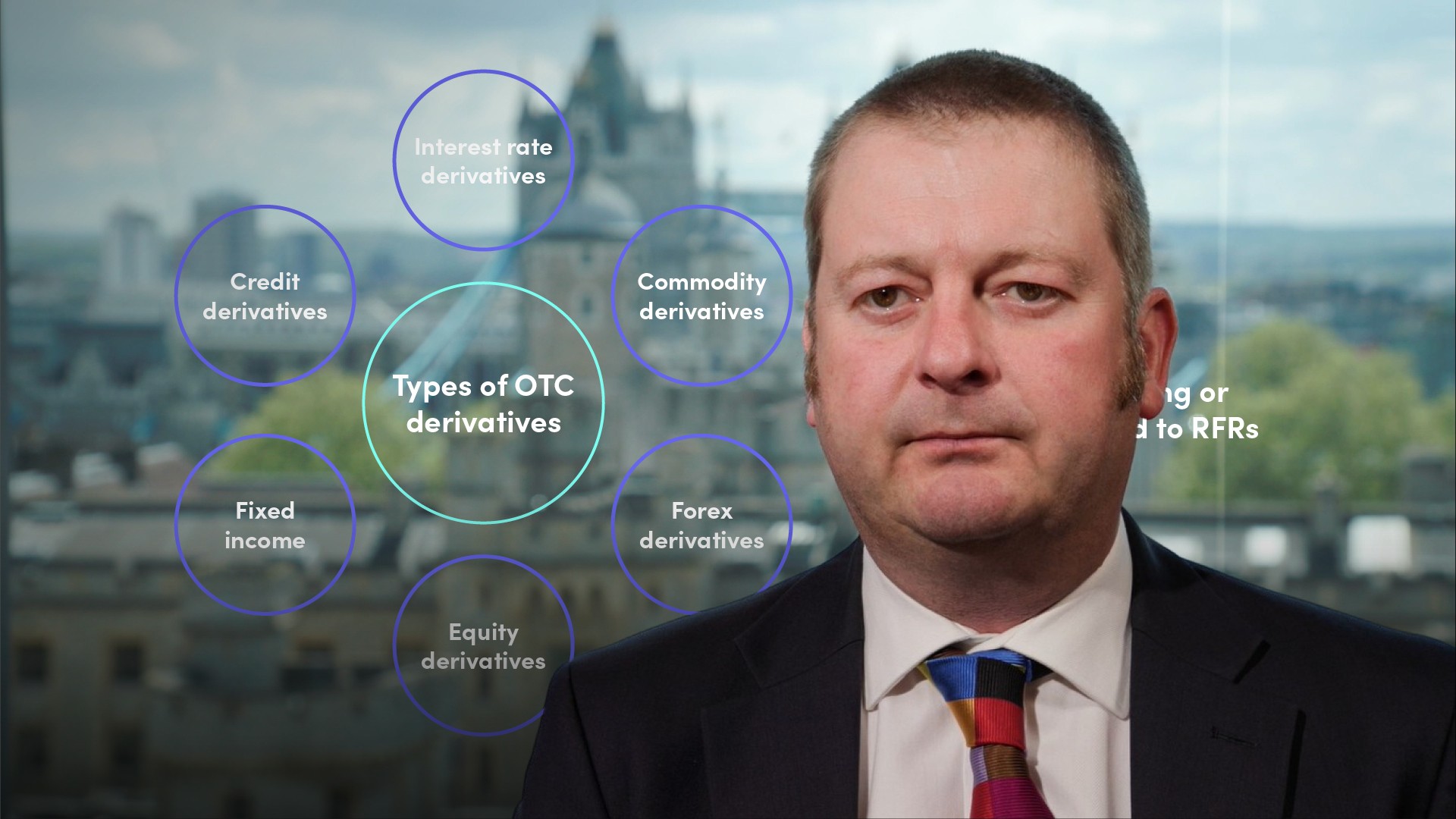
IBOR Transition Update by Asset Class (May 21)

John Ewan
20 years: Interest rate benchmarks
In this video, John outlines how LIBOR transition will work with individual types of assets. He takes us through cash, fixed income, loans, and derivative instruments.
In this video, John outlines how LIBOR transition will work with individual types of assets. He takes us through cash, fixed income, loans, and derivative instruments.
Subscribe to watch
Access this and all of the content on our platform by signing up for a 7-day free trial.

IBOR Transition Update by Asset Class (May 21)
13 mins 52 secs
Key learning objectives:
Understand how the LIBOR transition will work with Cash and loan products around the world
Understand how the LIBOR transition will work with Fixed Income Products
Understand how LIBOR Transition will work for Derivative products
Describe non-linear derivatives
Overview:
It is very likely that in the latter half of 2021 there will be regulation, guidance, protocols and other advice made available to firms with exposure to IBOR linked products. This includes cash, fixed income, loans, and derivatives instruments.
Subscribe to watch
Access this and all of the content on our platform by signing up for a 7-day free trial.
In transitioning to LIBOR - how big is the problem?
- As of May 2021 there are around 220 trillion dollars worth of products referencing US Dollar LIBOR whose expiry date is after June 2023. The majority of these are derivatives, for which there is a reasonably well laid trail for market participants to follow to mitigate their risks
- However, there is around USD 5 trillion in cash and bond products that reference US dollar LIBOR whose expiry is after June 2023 - 5 trillion dollars is one quarter of US GDP in 2020
How will LIBOR Transition work with Cash and loan products around the world?
There is explicit regulatory advice in the UK and US that market participants should not be entering into any new cash instruments that reference LIBOR as of now.
What are rates with a credit sensitivity element?
Where there is retail or commercial lending linked to LIBOR, these agreements will need to be novated to a new rate. This might be a Risk Free Rate, but we are also seeing increasing acceptance of rates that have a credit sensitivity element. Such rates include the ICE Bank Yield, the Bloomberg Short-Term Bank Yield, or BSBY, index, and SOFR add-ons, such as the SOFR Academy AXI or Across the Curve Index.
- The Federal Reserve and other US regulators have stated explicitly that these types of rates will be acceptable to regulators provided they meet a certain set of standards – and all will.
- In the UK, despite there being no prohibition on using rates with a credit sensitivity element, the Bank of England and Financial Conduct Authority have made clear their preference for all to use SONIA (or more specifically a Term SONIA Reference Rate).
- In Europe, this is not an issue. It seems that while there is an RFR available for use – the Euro Short Term Rate – the Euribor rate that market participants have been using since 1999 will be available for use until at least 2025.
How will LIBOR Transition work with Fixed Income Products?
The Governor of the Bank of England has recently spoken of over 50 bonds with a value of around £40 billion actively transitioned from GBP Libor to SONIA. This was achieved by negotiation and agreement between the bond issuer and all the bondholders, and the examples so far are all of relatively small bonds by value, and whose holders are small in number.
What are the difficulties with this?
The difficulty arises as contractual language in bonds that are linked to LIBOR or otherwise reference LIBOR often does not envisage the absence or unavailability of the rate. In many cases, there is also a requirement for all bondholders to agree unanimously to changes in the language. This is time consuming and logistically challenging in large, widely held issues.
However, regulators and central banks in the UK and US continue to ratchet up pressure on this issue. Regulators on both sides of the Atlantic have said that they expect to discuss with firms their plans to transition away from LIBOR in fixed-income products.
How will LIBOR Transition work for Derivative products?
- The major derivative exchanges and Clearing Houses are switching or have already switched to the use of Risk Free Rates in clearing, margin and Price Alignment Interest calculation
- The International Swaps and Derivatives Association, known as ISDA, has been pushing forward with the official sector. They have worked to enable a move for many derivatives, particularly those that trade over the counter, to Risk Free Rates
- Interest-Rate Swaps – by far the lion’s share by value of all outstanding products that reference LIBOR – are now being offered as products that reference Risk Free Rates in all major currencies
What about non-linear derivatives?
These are complex financial products that are not offered to retail customers or even many corporations. Nevertheless they make up a significant part of the landscape of LIBOR-linked products. The transition for these products to Risk Free Rates is not straightforward. Swaptions, caps and floors and other non-linear instruments that reference Risk Free rates are available.
Subscribe to watch
Access this and all of the content on our platform by signing up for a 7-day free trial.

John Ewan
There are no available Videos from "John Ewan"



























